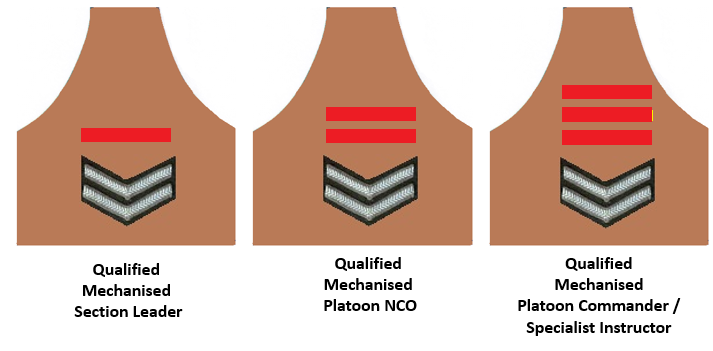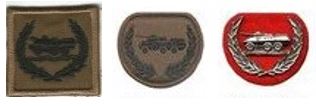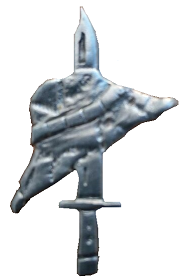4 South African Infantry Battalion on:
[Wikipedia]
[Google]
[Amazon]
4 South African Infantry Battalion (also known as 4 SAI) is a
 Similar to 1 SAI, 4 SAI's mechanised leaders followed the same training route all students attended the course until the Section Leaders Phase had been completed. Section Leaders were then awarded their Lance Corporal stripes and then placed with regular rifle companies. The rest of the future NCOs also received their stripes and future Officers received their white Candidate Officer's tabs. These students were then evaluated and split into the Mechanised Platoon Commanders Course and Specialist Instructors Course. These platoon commanders were destined to either become future leaders of 8 SAIs rifle companies or instructors at the Training Wing, while the Specialist Instructors would become Officers and NCO's responsible for training of Ratel gunners and drivers.
*All students qualifying as Section Leaders were authorised to wear one parallel red bar above their two Corporal stripes.
*Students that qualified as Platoon NCOs were authorised to wear two parallel red bars. The Platoon NCOs were responsible for the support of the vehicles, guns and signal equipment of a specific platoon.
*Students that completed either the Platoon Commanders or Specialist Instructors Course were permitted to wear three parallel red bars above their stripes, signifying their platoon sergeant status. Platoon sergeants were responsible for the training and discipline of an allocated platoon.
Similar to 1 SAI, 4 SAI's mechanised leaders followed the same training route all students attended the course until the Section Leaders Phase had been completed. Section Leaders were then awarded their Lance Corporal stripes and then placed with regular rifle companies. The rest of the future NCOs also received their stripes and future Officers received their white Candidate Officer's tabs. These students were then evaluated and split into the Mechanised Platoon Commanders Course and Specialist Instructors Course. These platoon commanders were destined to either become future leaders of 8 SAIs rifle companies or instructors at the Training Wing, while the Specialist Instructors would become Officers and NCO's responsible for training of Ratel gunners and drivers.
*All students qualifying as Section Leaders were authorised to wear one parallel red bar above their two Corporal stripes.
*Students that qualified as Platoon NCOs were authorised to wear two parallel red bars. The Platoon NCOs were responsible for the support of the vehicles, guns and signal equipment of a specific platoon.
*Students that completed either the Platoon Commanders or Specialist Instructors Course were permitted to wear three parallel red bars above their stripes, signifying their platoon sergeant status. Platoon sergeants were responsible for the training and discipline of an allocated platoon.

 * Hooper and
*
* Hooper and
* 




motorised infantry
Motorized infantry is infantry that is transported by trucks or other motor vehicles. It is distinguished from mechanized infantry, which is carried in armoured personnel carriers or infantry fighting vehicles, and from light infantry, which ...
unit of the South African Army
The South African Army is the principal land warfare force of South Africa, a part of the South African National Defence Force (SANDF), along with the South African Air Force, South African Navy and South African Military Health Service. ...
.
History
Pretoria Origins
4 SAI was established on 1 January 1962, at Voortrekkerhoogte in Pretoria, but within a month was moved toMiddelburg Middelburg may refer to:
Places and jurisdictions Europe
* Middelburg, Zeeland, the capital city of the province of Zeeland, southwestern Netherlands
** Roman Catholic Diocese of Middelburg, a former Catholic diocese with its see in the Zeeland ...
, South Africa
South Africa, officially the Republic of South Africa (RSA), is the southernmost country in Africa. It is bounded to the south by of coastline that stretch along the South Atlantic and Indian Oceans; to the north by the neighbouring countri ...
.
First troops began training in April 1962 and became an operational motorised unit in 1969.
From motorised to mechanised Infantry
By 1976 infantry operations transformed drastically when the Ratel Infantry Fighting Vehicle (IFV) was introduced for the first time and in November the first Ratel course was presented at 1 SAI. In 1982, 4 SAI converted to a mechanised infantry battalion mainly consisting of Ratel-20 IFVs. Similar to 1 SAI, 4 SAI's mechanised leaders followed the same training route all students attended the course until the Section Leaders Phase had been completed. Section Leaders were then awarded their Lance Corporal stripes and then placed with regular rifle companies. The rest of the future NCOs also received their stripes and future Officers received their white Candidate Officer's tabs. These students were then evaluated and split into the Mechanised Platoon Commanders Course and Specialist Instructors Course. These platoon commanders were destined to either become future leaders of 8 SAIs rifle companies or instructors at the Training Wing, while the Specialist Instructors would become Officers and NCO's responsible for training of Ratel gunners and drivers.
*All students qualifying as Section Leaders were authorised to wear one parallel red bar above their two Corporal stripes.
*Students that qualified as Platoon NCOs were authorised to wear two parallel red bars. The Platoon NCOs were responsible for the support of the vehicles, guns and signal equipment of a specific platoon.
*Students that completed either the Platoon Commanders or Specialist Instructors Course were permitted to wear three parallel red bars above their stripes, signifying their platoon sergeant status. Platoon sergeants were responsible for the training and discipline of an allocated platoon.
Similar to 1 SAI, 4 SAI's mechanised leaders followed the same training route all students attended the course until the Section Leaders Phase had been completed. Section Leaders were then awarded their Lance Corporal stripes and then placed with regular rifle companies. The rest of the future NCOs also received their stripes and future Officers received their white Candidate Officer's tabs. These students were then evaluated and split into the Mechanised Platoon Commanders Course and Specialist Instructors Course. These platoon commanders were destined to either become future leaders of 8 SAIs rifle companies or instructors at the Training Wing, while the Specialist Instructors would become Officers and NCO's responsible for training of Ratel gunners and drivers.
*All students qualifying as Section Leaders were authorised to wear one parallel red bar above their two Corporal stripes.
*Students that qualified as Platoon NCOs were authorised to wear two parallel red bars. The Platoon NCOs were responsible for the support of the vehicles, guns and signal equipment of a specific platoon.
*Students that completed either the Platoon Commanders or Specialist Instructors Course were permitted to wear three parallel red bars above their stripes, signifying their platoon sergeant status. Platoon sergeants were responsible for the training and discipline of an allocated platoon.

Operations in Border War
4 SAI took part in many external operations during the South African border war such as: * Dolfyn, *Askari
An askari (from Somali, Swahili and Arabic , , meaning "soldier" or "military", which also means "police" in the Somali language) was a local soldier serving in the armies of the European colonial powers in Africa, particularly in the African G ...
,
* Alpha Centauri
Alpha Centauri ( Latinized from α Centauri and often abbreviated Alpha Cen or α Cen) is a triple star system in the constellation of Centaurus. It consists of 3 stars: Alpha Centauri A (officially Rigil Kentaurus), Alpha Centaur ...
,
* Moduler,  * Hooper and
*
* Hooper and
* Prone
Prone position () is a body position in which the person lies flat with the chest down and the back up. In anatomical terms of location, the dorsal side is up, and the ventral side is down. The supine position is the 180° contrast.
Etymolog ...
.
For these operations, 4 SAI became a detached unit supplying mechanised infantry to 62 Mechanised Battalion Group
62 Mechanised Infantry Battalion Group was a unit of the South African Army (SADF); although it was classed as mechanized infantry, it was a combined arms force consisting of a Mechanised Infantry Battalion forming the core of the group, Main Bat ...
. An artillery battery of G5 howitzers, a Ratel-90 armoured car squadron and a in some operations, an Oilfant tank squadron was also temporarily attached to the battalion.



Operations in South Africa
4 SAI also supported the signing of the Nkomati accord between South Africa and Mozambique in March 1984 and took part in Exercise Thunder Chariot in September of that year. The exercise was, at the time, billed as the largest mobilisation of South African forces since World War II.Reverting to motorised infantry
4 SAI reverted to a motorised infantry unit after 1994.SANDF's Motorised Infantry
SANDF's Motorised Infantry is transported mostly by Samil trucks, Mamba APC's or other un-protected motor vehicles. Samil 20, 50 and 100 trucks transport soldiers, towing guns, and carrying equipment and supplies. Samil trucks are all-wheel drive, in order to have vehicles that function reliably in extremes of weather and terrain. Motorised Infantry have an advantage in mobility allowing them to move to critical sectors of the battlefield faster, allowing better response to enemy movements, as well as the ability to outmaneuver the enemyLeadership
Insignia
Previous Dress Insignia

Current Dress Insignia

References
{{SA Army Units Infantry battalions of South Africa Infantry regiments of South Africa Military units and formations of South Africa in the Border War Military units and formations established in 1962